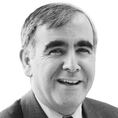Some minds improve by travel, wrote the poet and humorist, Thomas Hood: others, rather, resemble copper wire, or brass, which get the narrower by going farther. And so it was in a spirit of keen metallurgical inquiry that I ventured on a recent visiting professorship with the Australian and New Zealand Geriatric Medicine Society.
Warmly hosted, my first visit to “down-under” involved three cities, each with a very distinct character. Melbourne in winter is a mix of northern weather and southern café society, rich in architecture, culture and brio. Adelaide evokes a calmer pace, but offers an equally satisfying range of experiences, from a ramble through the blue and silver forests below Mount Lofty, to the pleasure of seeing the Southern Cross in a clear night sky in the Adelaide Hills.
Brisbane pulsates with a different type of energy; the river bike-way crafting a palette which includes cutting-edge cultural institutions, the subtropical botanic gardens, outdoor restaurants, and climbers on the cliff-faces of Kangaroo Point; the large fruit bats providing an eery nocturnal counterpoint.
The stand-out aesthetic experience in each city was the aboriginal art, vivid and rich, uniting a sense of the very new and the very ancient, with its modern iterations expressing a host of multi-layered messages. As late-life creativity was the focus of the lectures I gave, I was delighted to discover and include artists Sally Gabori and Emily Kame Kngwarreye, both active into their ninth decade.
The striking impression of geriatric medicine in Australia and New Zealand was of vibrancy, energy and confidence. As I visited very impressive clinical facilities, it became clear that an achievement of Australian geriatric medicine has been to persuade the federal government to adequately fund geriatric medicine in private services reimbursed by Medicare.
In most countries, operative procedures which take a few minutes are reimbursed at an astronomically higher level than the hour of sophisticated clinical work that a comprehensive geriatric assessment often requires. The result is that geriatric medicine, an intervention of high efficacy, is virtually non-existent in private medicine in much of the world. That Australia has reversed this trend is the sign of a highly developed society.
But where my eyes were opened (or my copper-wire stretched!) was my encounter with the winning combination of smart gerontological thinking and technologies.
In the Prince Charles Hospital in Brisbane, the acute medical service is run largely by geriatricians. The lead clinician, Dr Liz Whiting (a TCD graduate), and her team have developed an enormously impressive "journey board" (couriermail. com.au), which embodies diagnosis, functional status and the workings and actions of the multi-disciplinary team on an electronic white-board which is intuitive, goal-oriented and effective.
Over at the Centre for Online Health of the University of Queensland (uq.edu.au/coh/telehealth), I was fascinated by how they combined the cutting-edge gerontological practice inherent in the interRAI (the gold standard for assessing needs in older people, adopted by over 30 countries – including most recently Ireland) with telehealth.
While sitting in on a tele-consult in a nursing home 210km away in the outback I was struck by how use of the interRAI tool by the nurse in the home provided her with much of the information and some of the solutions needed in this case: it clearly empowered her and facilitated the consultation. The technology, while of the highest quality, with the robot quite acceptable to the patient, was the servant rather than the master: the experience has urged me to rethink how we undertake telemedicine in our own service in Tallaght and Naas hospitals for acute stroke care. Such experiences are invaluable for the cross-fertilisation of ideas that can help to continually improve services for older people in an ever smaller world.
A version of this column originally appeared as a BMJ blog.
Prof Des O’Neill is a consultant in geriatric and stroke medicine

















